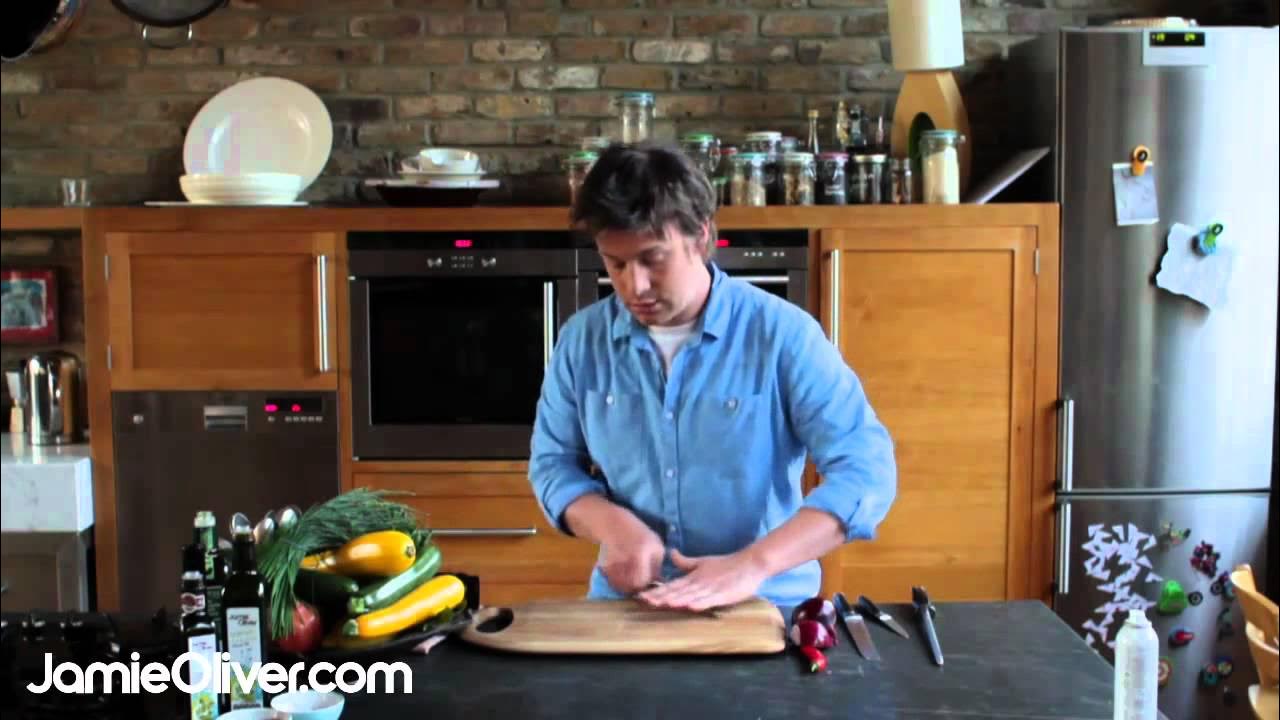How to Master Basic Knife Skills - Knife Cuts 101
Summary
TLDRChef Billy Parisi's video offers an in-depth tutorial on essential knife skills for cooking enthusiasts. He emphasizes the importance of selecting the right chef's knife, maintaining its sharpness, and proper knife handling to prevent injuries. The video demonstrates various cutting techniques, including brunoise, dice of different sizes, batonnet, julienne, rough chop, fine mince, and chiffonade, particularly for garnishes and specific dishes. Parisi encourages practice to master these skills, suggesting recipes like Chicken Detox Soup and Arroz con Pollo to apply these cuts.
Takeaways
- 🔪 The chef's knife, also known as a French knife, is the most commonly used knife in professional kitchens, suitable for a variety of tasks.
- ⚔️ A good chef's knife should be between 8 to 12 inches, with a sturdy handle and a thick blade, and is typically priced at $100 or more.
- 🚫 Japanese blades, like Shun knives, are very sharp but brittle, so they should not be used for cutting bones or hard items.
- 💧 Proper knife care includes hand washing with soap and water, avoiding the dishwasher, and regular sharpening with a steel or stone.
- 🤚 Correct knife handling involves pinching the blade with the thumb and pointer finger, which will eventually lead to the development of a protective callous.
- 🥕 For safety, always tuck in your fingertips when holding food while cutting, and let the blade run along the knuckles of your hand.
- 🔼 The brunoise cut is a small 1/8-inch cube, used for garnishes and in soups, requiring precise and even slicing.
- 🎲 Dicing comes in various sizes: small (1/4-inch), medium (1/2-inch), and large (3/4-inch) dice, each with specific uses in cooking.
- 🥔 Batonnet is a cut that is 1/4-inch by 1/4-inch by two inches long, often used as a garnish or in salads.
- 🥕 Julienne is a matchstick cut of 1/8-inch by 1/8-inch by two inches, used in dishes that require a consistent, thin, and long shape.
- 👨🍳 Practice is essential for mastering knife skills, with the culinary adage suggesting that one must perform a cut 1000 times to truly master it.
Q & A
What is the primary focus of Chef Billy Parisi's video?
-The primary focus of Chef Billy Parisi's video is to demonstrate perfect knife skills that are essential for anyone who loves to cook.
Why does Chef Billy emphasize the importance of using the right knife?
-Chef Billy emphasizes the importance of using the right knife because it is the most commonly used tool in cooking, especially in professional kitchens, and it's crucial for executing various knife skills effectively.
What is the chef's knife, also known as, and what are its typical dimensions?
-The chef's knife is also known as a French knife, and it typically measures between eight and 12 inches in length.
Why does Chef Billy recommend against using a Japanese blade for certain tasks?
-Chef Billy recommends against using a Japanese blade for tasks like hacking through bones because they are very sharp but brittle, which can cause the blade to chip.
How much does a good chef's knife usually cost, according to Chef Billy?
-A good chef's knife will likely cost $100 or more, as mentioned by Chef Billy.
What are some ways to maintain a chef's knife as suggested by Chef Billy?
-To maintain a chef's knife, Chef Billy suggests scrubbing it with soap and water by hand, not putting it in the dishwasher, and keeping it sharp by using a steel or sharpening stone.
How should one hold a knife properly according to the video?
-One should hold a knife by pinching it by the blade using the thumb and pointer finger, allowing the top of the blade to push into the hand to develop a callous over time.
What is the brunoise knife cut and what is it typically used for?
-The brunoise is a small 1/8-inch cube knife cut, often used for garnishes, consommes, soups, and other garnishing purposes.
What is the significance of tucking in fingertips when holding food while cutting?
-Tucking in fingertips when holding food while cutting is significant for safety, as it prevents accidental cuts and provides better control over the food item.
What is the difference between a small dice and a medium dice cut?
-A small dice cut is a 1/4-inch cube, while a medium dice cut is a 1/2-inch cube. Both are used in cooking for different textures and presentation.
What is a batonnet knife cut and what is it used for?
-A batonnet is a knife cut that is 1/4 of an inch by 1/4 of an inch by two inches in length, typically used as garnishes or in salads and side dishes.
How does Chef Billy suggest practicing knife skills?
-Chef Billy suggests practicing knife skills by starting with basic cuts and gradually moving onto more complex ones, emphasizing the importance of practice and using these skills in actual recipes.
Outlines

هذا القسم متوفر فقط للمشتركين. يرجى الترقية للوصول إلى هذه الميزة.
قم بالترقية الآنMindmap

هذا القسم متوفر فقط للمشتركين. يرجى الترقية للوصول إلى هذه الميزة.
قم بالترقية الآنKeywords

هذا القسم متوفر فقط للمشتركين. يرجى الترقية للوصول إلى هذه الميزة.
قم بالترقية الآنHighlights

هذا القسم متوفر فقط للمشتركين. يرجى الترقية للوصول إلى هذه الميزة.
قم بالترقية الآنTranscripts

هذا القسم متوفر فقط للمشتركين. يرجى الترقية للوصول إلى هذه الميزة.
قم بالترقية الآنتصفح المزيد من مقاطع الفيديو ذات الصلة
5.0 / 5 (0 votes)






